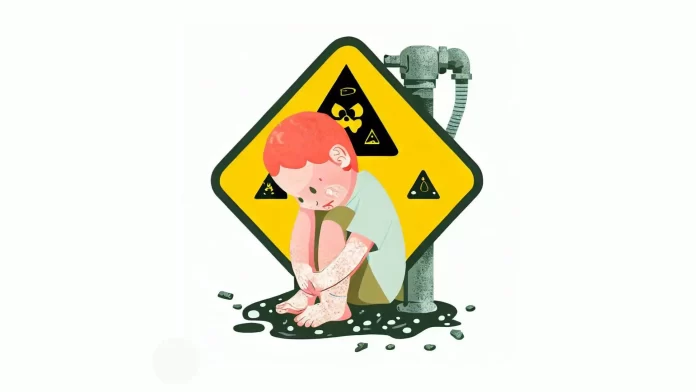Lead poisoning, a preventable environmental hazard, has plagued human societies for centuries. Despite awareness and progress in recent years, it continues to be a global health concern.
Lead poisoning occurs when the body absorbs and accumulates high levels of lead, a naturally occurring heavy metal.
It can occur through various pathways, including ingestion, inhalation, or contact with lead-contaminated substances or environments.
Infants, children, and pregnant women are particularly vulnerable due to the adverse effects on developing brains and bodies.
According to the World Health Organization (WHO), lead exposure accounts for 1.06 million deaths annually, with the highest burden falling on low- and middle-income countries.
Sources of Lead Exposure
Lead can be found in various sources, posing risks to human health. One significant source is lead-based paints, particularly in older buildings and homes.
The Centers for Disease Control and Prevention (CDC) estimates that approximately 24 million housing units in the United States alone have deteriorated lead-based paint (2).
Another substantial source of lead exposure is lead-contaminated soil and dust, which can originate from multiple factors such as industrial activities, smelters, and proximity to lead-emitting facilities.
The Global Burden of Disease Study estimates that lead exposure through contaminated soil is responsible for 8.9% of global lead-related deaths (3).
Harmful Effects of Lead Poisoning
Lead is a potent neurotoxin, and even low levels of exposure can have severe health consequences.
In children, lead poisoning can impair cognitive development, lower IQ levels, cause behavioral problems, affect hearing and speech, and lead to learning difficulties.
It also increases the risk of developmental disorders, including Attention Deficit Hyperactivity Disorder (ADHD) and autism spectrum disorders (4).
In adults, lead exposure can lead to cardiovascular issues, kidney damage, reproductive problems, and neurological disorders.
Furthermore, emerging research suggests potential links between lead exposure and adverse health outcomes such as hypertension, renal dysfunction, and increased mortality.
Diagnosis and Treatment
Diagnosing lead poisoning involves blood tests to measure lead levels. The CDC recommends testing children at ages 1 and 2, or between 3 and 6 years if not previously tested.
Prompt intervention is crucial if elevated lead levels are found.
Treatment may involve identifying and removing the source of exposure, chelation therapy to remove lead from the body, and supportive care to manage symptoms and complications.
Global Efforts and Conventions
Recognizing the gravity of lead poisoning, global efforts have been made to address this public health concern.
The United Nations Environment Programme (UNEP) and WHO have initiated conventions and programs to reduce lead exposure and eliminate lead in various sectors.
The Minamata Convention on Mercury, adopted by over 120 countries, aims to protect human health and the environment from heavy metal pollution, including lead.
Domestic Measures and Regulations
Countries worldwide have implemented regulations to tackle lead poisoning. For instance, the phase-out of leaded gasoline has significantly reduced lead exposure levels globally.
Additionally, restrictions on lead content in consumer products, lead abatement programs, and the establishment of safe drinking water standards have contributed to reducing lead exposure risks.
According to the CDC, since the removal of lead from gasoline in the United States, the average blood lead levels in children have decreased by more than 90% (6).
Promoting Alternative Technologies and Practices
Reducing reliance on lead-containing materials is vital in mitigating lead poisoning risks.
Efforts are underway to develop and promote alternative technologies, such as lead-free plumbing materials, lead-safe construction practices, and lead-free electronics.
Additionally, sustainable urban planning, pollution control measures, and public awareness campaigns contribute to reducing lead exposure risks.
Latest Developments and Research
Ongoing research and technological advancements continue to shed light on lead poisoning prevention and treatment.
Researchers are developing more accurate and accessible testing methods, exploring innovative cleanup technologies for lead-contaminated sites, and studying the long-term effects of low-level lead exposure.
For instance, recent studies have highlighted the importance of early interventions and education programs in mitigating the detrimental effects of lead exposure.
Targeted interventions that include nutritional support and environmental remediation have shown promise in reducing blood lead levels and improving neurodevelopmental outcomes in children.
Conclusion
Lead poisoning remains a significant global health concern, with millions of individuals affected by its detrimental effects.
However, progress has been made in understanding its sources, harmful effects, and preventive measures.
Efforts to eliminate lead exposure require a multi-faceted approach, including awareness campaigns, policy regulations, public health interventions, and the promotion of alternative technologies.
By prioritizing prevention, raising awareness, and implementing robust measures, we can protect future generations from the devastating impact of lead poisoning.
It is crucial to continue supporting research and collaborating on a global scale to work towards a lead-free future where every individual can thrive in a safe and healthy environment.
